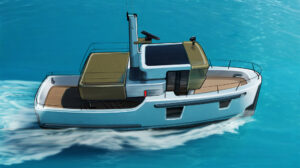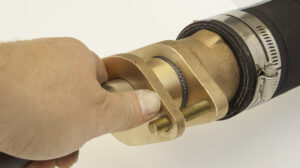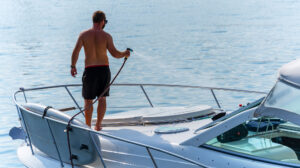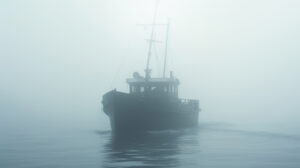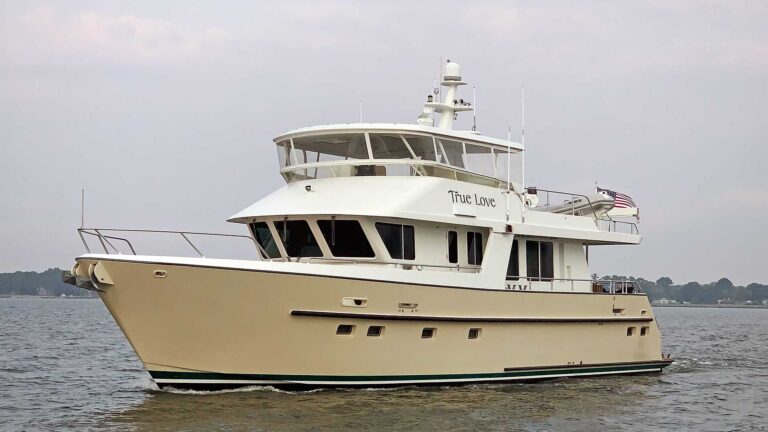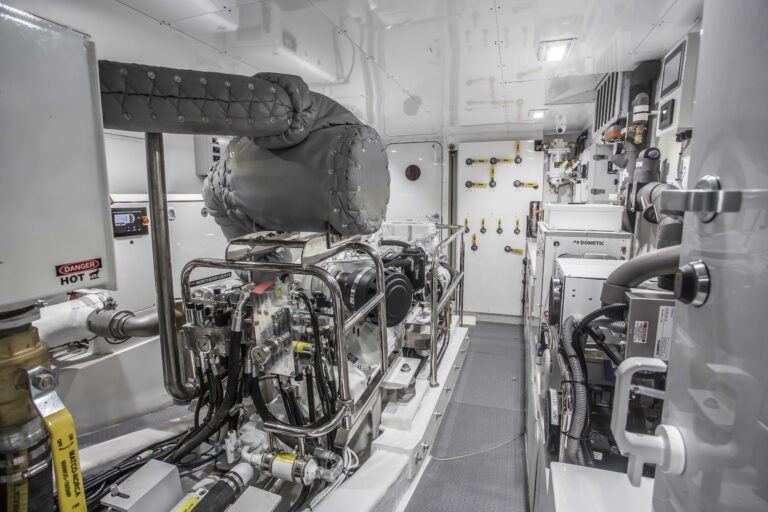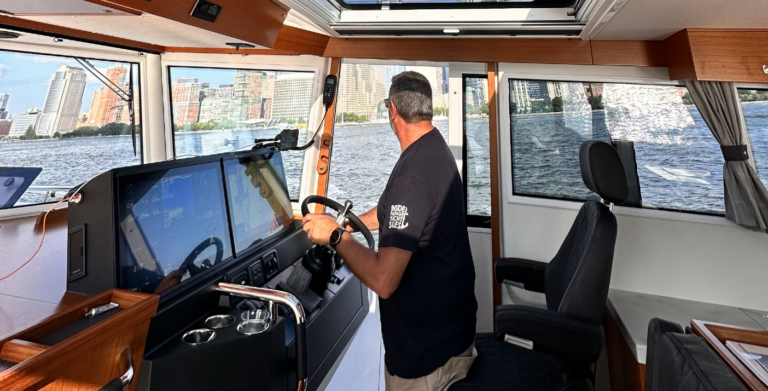While carrying out an inspection aboard the vessel that PMMuses to test and evaluate new equipment, I noticed that the onboard carbon monoxide detectors appeared to be the original units that had been installed during construction or commissioning. This meant the detectors were at least 12 years old.
It’s a little-known fact that most marine carbon monoxide detectors have a finite life span, and in most cases, there’s no way to test their effectiveness or accuracy. It was time for these units to be replaced, presenting us an excellent opportunity to visit this subject with our readers.
Carbon monoxide (CO) is an odorless, colorless, tasteless gas that’s produced when carbon-bearing fuels such as gasoline, diesel, LP gas, coal, or wood are burned. Typically, CO’s density is “neutral,” which means it often distributes itself evenly throughout a cabin or compartment. When inhaled in sufficient quantities, CO inhibits blood cells from carrying oxygen, which eventually leads to unconsciousness and then death. Inhaling a low concentration of CO over a long period of time may be just as deadly as breathing in a high concentration over a shorter period. Make no mistake about it-carbon monoxide is a silent killer that continues to take the lives of boaters and others who use carbon-based fuels.
That’s the bad news. The good news is that injuries and deaths from CO poisoning are completely avoidable with the use of an inexpensive device that’s designed to detect CO gas. These devices are readily available, often for much less than it costs to fill up your car’s gas tank. As far as I’m concerned, CO detectors are not an option; every vessel should be equipped with a detector in each accommodations space-wherever someone might sleep or nap-even if there are no CO-producing devices aboard. That means every cabin where there’s a bed or settee should have a detector, period.
This brings up a question I’m often asked: why do you need a CO detector if you don’t have any CO-producing devices aboard (or don’t seem to have any)? Boaters have been killed by carbon monoxide produced by other vessels, and virtually all boats have at least one CO-producing device on board. (Contrary to popular belief, diesel engines do produce CO, although they do so in smaller quantities than other sources.) If your hatches are open and you are moored or docked downwind of a vessel that is running a generator overnight to operate air conditioning, you are susceptible to secondary CO poisoning. While this may sound unlikely, it has happened.
IT’S ALL ABOUT THE POWER
There are significant differences between the CO detectors designed for household use-those sold at home-improvement stores, for instance-and those intended for use on boats. One of the primary differences is the power supply. Marine CO detectors operate from the vessel’s own 12- or 24-volt house DC power supply, while those marketed for use in homes and businesses typically run on 120-volt AC (what mariners know as shorepower), or from internal AA or 9-volt batteries. Why does the power source matter? In most cases, either type of CO detector will detect carbon monoxide and warn occupants of a home or cruising vessel of its presence. The difference is in the reliability and availability of the power supply.
Because shorepower is not always available aboard the average cruising vessel, it’s not appropriate as a power source for onboard CO detectors. Detectors powered by internal 9-volt or AA batteries also present a problem. Unlike homes and businesses, recreational vessels are not continuously occupied, so the battery in a CO detector may go dead without warning. Even if it chirps for weeks before it dies, there may be no one aboard to hear this critical signal, particularly if it occurs during off-season storage.
The most reliable type of CO detector for onboard use utilizes the vessel’s own DC power supply. Additionally, the power supply for CO detectors should be wired through a fuse or circuit breaker that cannot be inadvertently turned off (the latter usually are of the push-button variety, rather than the lever type). CO detectors typically are wired in the “always energized” mode. They always use current, not just when CO is present, so they are capable of draining a battery over a long period of time if no charge source is present. (A small solar panel will typically keep up with one or two CO detectors.)
If current consumption is an issue, as in the case of moored vessels or where shorepower is not present, detectors may be wired-without switches or any other means of turning them off-to the “load” or “output” side of the house battery switch. This means that whenever the battery switch is on, which is the case when the boat is occupied, the CO detector is operational. If CO detectors are wired in this manner, a placard should be placed next to the battery switch to indicate that when the switch is off, the CO detectors also are off.
It’s not unusual for professional boatyards to disable or disconnect CO detectors during off-season storage. Doing so has two purposes: it prevents batteries from being drained, and it extends the life of the detectors. This is standard procedure in many yards; however, those carrying out this task must also prominently placard the vessel’s electrical panel or helm as a reminder to reactivate the CO detectors when the vessel is commissioned.
AN EXCEPTION TO THE RULES
At this point, my stance on CO detectors should be clear: Every vessel needs at least one CO detector, and most cruising boats need multiple units. In addition, detectors need to be serviced and replaced periodically, and they should be powered from the vessel’s onboard DC system.
Having said this, I’d like to add that there are exceptions to the rules. As remarkable as it may sound, many of the vessels I inspect, both new and already in service, are not equipped with CO detectors. Installing detectors on these boats-wiring each unit with a dedicated, un-switched power supply-can be costly and time consuming. The alternative is to use carbon monoxide detectors powered by internal, replaceable batteries. While this is not ideal (for all of the aforementioned reasons), it’s preferable to cruising or sleeping aboard a vessel even one time without the protection of a CO detector. Today, you can buy an internal-battery-operated combination smoke and CO detector for less than $30.
If you do take this approach, you absolutely must test your CO detectors and replace the batteries with scrupulous regularity.
DON’T TAKE CHANCES
If your boat is equipped with CO detectors, either hardwired or battery operated, and they are more than five years old (as those aboard our test vessel were), replace them with new units. If you are unsure of the age of the detectors aboard your boat, take no chances and consult the manufacturer to determine their replacement interval, or simply replace them with new detectors. Many CO detectors have their date of manufacture, or a manufacturer’s code that corresponds to the date they were made, stamped on the mounting base. The units aboard our test vessel had served their purpose and were honorably retired and replaced with new Fireboy-Xintex CMD-4-MR stand-alone detectors (see http://www.fireboy-xintex.com/co-detectors.html). For larger boats or for boat owners who wish to set up a CO detector “network,” Fireboy-Xintex offers detectors that will trigger all units when any one sounds.
Just as a good mariner never relies on one source of navigational information, prudent skippers will never rely solely on CO detectors to alert them to the presence of carbon monoxide. Early symptoms of CO poisoning include nausea, headache, and drowsiness. You also may notice an exhaust odor, although this is not always the case. While these “symptoms” often are encountered under normal cruising conditions, never ignore them if they seem unusually severe or otherwise out of the ordinary (and you should never smell exhaust odors in accommodations spaces). By the same token, never assume that a CO alarm is false because you’ve noticed none of these symptoms. When in doubt, ventilate the vessel thoroughly; if the alarm ceases, then it was likely a legitimate signal.
Finally, because prevention is preferable to detection, routinely inspect your vessel’s exhaust systems-engines and generators, gasoline and diesel systems, and combustion-style heating systems-to make certain no deterioration or leaks are present. If your boat is prone to the “station wagon effect,” whereby exhaust fumes follow you and enter the cabin while under way, be certain to properly ventilate accommodations spaces by opening forward hatches.



